Papers by Nataliya Mylenko
bl ic Di sc lo su re A ut ho riz ed Pu bl ic Di sc lo su re A ut ho riz ed Pu bl ic Di sc lo su r... more bl ic Di sc lo su re A ut ho riz ed Pu bl ic Di sc lo su re A ut ho riz ed Pu bl ic Di sc lo su re A ut ho riz ed Pu bl ic Di sc lo su re A ut ho riz ed Produced by the Research Support Team
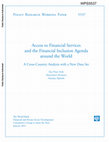
Recent empirical evidence highlights that access to basic financial services can make a substanti... more Recent empirical evidence highlights that access to basic financial services can make a substantial positive difference in improving poor people’s lives. Accordingly, financial sector reforms that promote financial inclusion are increasingly at the core of policymakers ’ agendas. The Consultative Group to Assist the Poor and the World Bank Group, in response, launched the Financial Access project, including a cross-country database on financial inclusion topics and an annual report to inform the policy debate. Using this database, this paper (i) counts the number of unbanked adults around the world at 56 percent, (ii) analyzes the state of access to deposit and loan services as well as the extent of retail networks, and (iii) discusses the state of financial inclusion mandates around the world. This paper is a product of the Financial Access Team in Consultative Group to Assist the Poor, Financial and Private Sector Development. It is part of a larger effort by the World Bank to pro...
This newsletter includes the following headings: the World Bank Philippines’ growth outlook is po... more This newsletter includes the following headings: the World Bank Philippines’ growth outlook is positive with upside risks; in September, manufacturing activities continued to expand with several sectors working close to full capacity; the banking system shows ample liquidity and strong credit growth; October headline inflation was steady while food inflation inched up further impacted by adverse weather conditions; the national government deficit widened in January-September as expenditure growth outpaced revenue growth; and poverty fell significantly in 2015, as improved employment outcomes, incomes, and social welfare programs lifted 1.8 million Filipinos out of poverty since 2012.
Access Finance, Apr 1, 2005
Sharing information on borrower credit histories allows lenders to improve risk management and ex... more Sharing information on borrower credit histories allows lenders to improve risk management and expand lending to new market segments. Correlation between existence of credit information registries and depth of credit markets is widely documented. There is also evidence that the private sector is better suited to serve the needs of lenders by providing detailed credit history information and value-added services, such as credit scoring, while public credit registries, run by bank supervisors, should focus on monitoring systemic risks.
Policy Research Working Paper Series, 2010
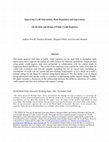
This paper analyzes how data in public credit registries can be used both to strengthen bank supe... more This paper analyzes how data in public credit registries can be used both to strengthen bank supervision and to improve the quality of credit analysis by financial institutions. Empirical tests using public credit registry data were performed in collaboration with the central banks in Argentina, Brazil and Mexico. The results of the empirical tests confirm the value of the data for credit risk evaluation and provide insights regarding its use in supervision, including in calculations of credit risk for capital and provisioning requirements or as a check on a bank's internal ratings for the Basel II's internal rating-based approach. We also define a set of critical design parameters and use the results to comment on appropriate public registry design. Finally, the paper includes a discussion of the relationship between the different objectives of a public credit registry and how they influence the registry's design. from Banco de Mexico and Ricardo Schectman from Banco Central do Brazil for invaluable help and support in the quantitative analysis.
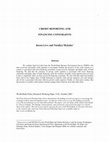
We combine firm-level data from the World Bank Business Environment Survey (WBES) with data on pr... more We combine firm-level data from the World Bank Business Environment Survey (WBES) with data on private and public credit registries to investigate whether the presence of the credit registry in a country is associated with lower financing constraints, as perceived by managers and higher share of bank financing. We find that the existence of private credit registries is associated with lower financing constraints and higher share of bank financing, while the existence of public credit registries does not seem to have a significant effect on these perceived financing constraints. We also find that small and medium firms tend to have higher share of bank financing in countries where private registries exist and stronger rule of law is associated with more effective private credit registries. Finally, we find some evidence that the presence of a public credit registry benefits younger firms relatively more than older firms.
Policy Research Working Papers, 2011
Policy Research Working Papers, 2011
Pacific Economic Review, 2012
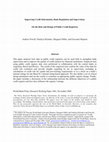
Policy Research Working Papers, 2004
This paper analyzes how data in public credit registries can be used both to strengthen bank supe... more This paper analyzes how data in public credit registries can be used both to strengthen bank supervision and to improve the quality of credit analysis by financial institutions. Empirical tests using public credit registry data were performed in collaboration with the central banks in Argentina, Brazil and Mexico. The results of the empirical tests confirm the value of the data for credit risk evaluation and provide insights regarding its use in supervision, including in calculations of credit risk for capital and provisioning requirements or as a check on a bank's internal ratings for the Basel II's internal rating-based approach. We also define a set of critical design parameters and use the results to comment on appropriate public registry design. Finally, the paper includes a discussion of the relationship between the different objectives of a public credit registry and how they influence the registry's design. from Banco de Mexico and Ricardo Schectman from Banco Central do Brazil for invaluable help and support in the quantitative analysis.
Policy Research Working Papers, 2011
Policy Research Working Papers, 2010
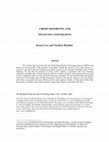
Policy Research Working Papers, 2003
We combine firm-level data from the World Bank Business Environment Survey (WBES) with data on pr... more We combine firm-level data from the World Bank Business Environment Survey (WBES) with data on private and public credit registries to investigate whether the presence of the credit registry in a country is associated with lower financing constraints, as perceived by managers and higher share of bank financing. We find that the existence of private credit registries is associated with lower financing constraints and higher share of bank financing, while the existence of public credit registries does not seem to have a significant effect on these perceived financing constraints. We also find that small and medium firms tend to have higher share of bank financing in countries where private registries exist and stronger rule of law is associated with more effective private credit registries. Finally, we find some evidence that the presence of a public credit registry benefits younger firms relatively more than older firms.

Uploads
Papers by Nataliya Mylenko